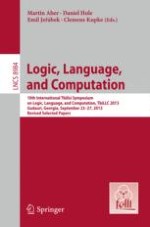This book constitutes the refereed proceedings of the 10th International Tbilisi Symposium on Logic, Language and Computation, TbiLLC 2013, held in Gudauri, Georgia, in September 2013. The conference series is centered around the interaction between logic, language and computation. The contributions represent these three fields and the symposia aim to foster interaction between them.
The book consists of 16 papers that were carefully reviewed and selected from 26 submissions. Each paper has passed through a rigorous peer-review process before being accepted for publication. The volume also contains two summaries of the tutorials that took place at the symposium: the one on admissible rules and the one on the formal semantics of aspectual meaning from a cross-linguistic perspective.
